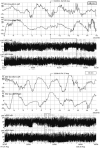Modulation of EEG spectral edge frequency during patterned pneumatic oral stimulation in preterm infants
- PMID: 24129553
- PMCID: PMC4005474
- DOI: 10.1038/pr.2013.179
Modulation of EEG spectral edge frequency during patterned pneumatic oral stimulation in preterm infants
Abstract
Background: Stimulation of the nervous system plays a central role in brain development and neurodevelopmental outcomes. Thalamocortical and corticocortical development is diminished in premature infants and correlated to electroencephalography (EEG) progression. The purpose of this study was to determine the effects of orocutaneous stimulation on the modulation of spectral edge frequency fc = 90% (SEF-90), which is derived from EEG recordings in preterm infants.
Methods: A total of 22 preterm infants were randomized to experimental and control conditions. Pulsed orocutaneous stimulation was presented during gavage feedings begun at ~32 wk postmenstrual age. The SEF-90 was derived from two-channel EEG recordings.
Results: Compared with the control condition, the pulsed orocutaneous stimulation produced a significant reorganization of SEF-90 in the left (P = 0.005) and right (P < 0.0001) hemispheres. Notably, the left and right hemispheres showed a reversal in the polarity of frequency shift, demonstrating hemispheric asymmetry in the frequency domain. Pulsed orocutaneous stimulation also produced a significant pattern of short-term cortical adaptation and a long-term neural adaptation manifested as a 0.5 Hz elevation in SEF-90 after repeated stimulation sessions.
Conclusion: This is the first study to demonstrate the modulating effects of a servo-controlled oral somatosensory input on the spectral features of EEG activity in preterm infants.
Figures





Similar articles
-
Frequency-modulated orocutaneous stimulation promotes non-nutritive suck development in preterm infants with respiratory distress syndrome or chronic lung disease.J Perinatol. 2014 Feb;34(2):136-42. doi: 10.1038/jp.2013.149. Epub 2013 Dec 5. J Perinatol. 2014. PMID: 24310444 Free PMC article. Clinical Trial.
-
Amplitude-integrated EEG and range-EEG modulation associated with pneumatic orocutaneous stimulation in preterm infants.J Perinatol. 2014 Mar;34(3):213-9. doi: 10.1038/jp.2013.150. Epub 2013 Dec 5. J Perinatol. 2014. PMID: 24310443 Free PMC article. Clinical Trial.
-
Maturational changes in automated EEG spectral power analysis in preterm infants.Pediatr Res. 2011 Nov;70(5):529-34. doi: 10.1203/PDR.0b013e31822d748b. Pediatr Res. 2011. PMID: 21772227
-
Background EEG features and prediction of cognitive outcomes in very preterm infants: A systematic review.Early Hum Dev. 2018 Dec;127:74-84. doi: 10.1016/j.earlhumdev.2018.09.015. Epub 2018 Oct 16. Early Hum Dev. 2018. PMID: 30340071
-
EEG - A Valuable Biomarker of Brain Injury in Preterm Infants.Dev Neurosci. 2017;39(1-4):23-35. doi: 10.1159/000456659. Epub 2017 Apr 13. Dev Neurosci. 2017. PMID: 28402972 Review.
Cited by
-
Frequency-modulated orocutaneous stimulation promotes non-nutritive suck development in preterm infants with respiratory distress syndrome or chronic lung disease.J Perinatol. 2014 Feb;34(2):136-42. doi: 10.1038/jp.2013.149. Epub 2013 Dec 5. J Perinatol. 2014. PMID: 24310444 Free PMC article. Clinical Trial.
-
Structural and functional brain asymmetries in the early phases of life: a scoping review.Brain Struct Funct. 2022 Mar;227(2):479-496. doi: 10.1007/s00429-021-02256-1. Epub 2021 Mar 18. Brain Struct Funct. 2022. PMID: 33738578 Free PMC article.
-
Sensory-based interventions in the NICU: systematic review of effects on preterm brain development.Pediatr Res. 2022 Jul;92(1):47-60. doi: 10.1038/s41390-021-01718-w. Epub 2021 Sep 10. Pediatr Res. 2022. PMID: 34508227
-
Patterned frequency-modulated oral stimulation in preterm infants: A multicenter randomized controlled trial.PLoS One. 2019 Feb 28;14(2):e0212675. doi: 10.1371/journal.pone.0212675. eCollection 2019. PLoS One. 2019. PMID: 30817764 Free PMC article. Clinical Trial.
-
Non-nutritive sucking for increasing physiologic stability and nutrition in preterm infants.Cochrane Database Syst Rev. 2016 Oct 4;10(10):CD001071. doi: 10.1002/14651858.CD001071.pub3. Cochrane Database Syst Rev. 2016. PMID: 27699765 Free PMC article.
References
-
- Penn AA, Shatz CJ. Brain waves and brain wiring: the role of endogenous and sensory-driven neural activity in development. Pediatr Res. 1999;45:447–58. - PubMed
Publication types
MeSH terms
Grants and funding
LinkOut - more resources
Full Text Sources
Other Literature Sources
Medical

